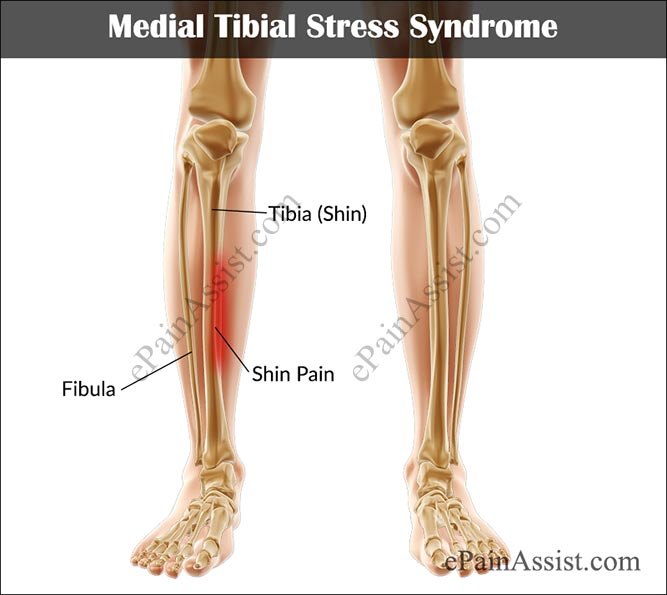Medial Tibial Stress Syndrome is also known as shin splints or tibial periostitis. These injuries are commonly suffered by those athletes who engage in running sports or basic activities such as cross country, football, or hiking. The main characteristic of Medial Tibial Stress Syndrome[¹] is pain in the lower part of the leg between the knee and the ankle. Repeated trauma to the connective muscle tissue surrounding the tibia brings about Medial Tibial Stress Syndrome injuries. This may result in more serious conditions, if left untreated or ignored, such as stress fracture of the bones.

Causes Of Medial Tibial Stress Syndrome or Shin Splints
Medial Tibial Stress Syndrome can be attributed to overloading the muscles of the lower extremities or biomechanical irregularities. Muscle imbalance, including weakened core muscles lead to more lower-extremity injuries; also the inflexibility and tightness of the gastrocnemius, soleus, and plantar muscles (commonly the flexor digitorum longus) can contribute to medial tibial stress syndrome. Increasing activity, intensity, and duration too quickly leads to medial tibial stress syndrome or shin splints because the tendons and muscles are unable to absorb the impact of the shock force as they become fatigued; also, the tibial bone-remodeling capabilities are overloaded. Some experts believe that this pain is caused from disruption of Sharpey’s fibres[²] that connect the medial soleus fascia through the periosteum of the tibia to insert into the bone. With repetitive stress, the impact forces eccentrically fatigue the soleus and create repeated tibial bending or bowing; thus, contributing to Medial Tibial Stress Syndrome. The impact is made worse by running uphill, downhill, on uneven terrain, or on hard surfaces. Improper footwear, including worn-out shoes can also contribute to medial tibial stress syndrome.
Risk Factors For Developing Medial Tibial Stress Syndrome or Shin Splints Include
- Excessive pronation at subtalar joint.
- Excessively tight calf muscles (which can cause excessive pronation).
- Engaging the medial shin muscle in excessive amounts of eccentric muscle activity.
- Undertaking high-impact exercises on hard surfaces.
While Medial Tibial Stress Syndrome or Shin Splints is the most common name, other conditions often overlap as causes including compartment syndrome and stress fractures. Females are 1.5 to 3.5 times more likely to progress to stress fractures from medial tibial stress syndrome. This is mostly due in part to females having a higher incidence of diminished bone density and osteoporosis. Medial tibial stress syndrome pain is described as a recurring dull ache along the posteromedial aspect of the distal two-thirds of the tibia; the difference in stress fracture pain[³] is that it is typically localized to the fracture site and is more proximal than the pain caused by Medial Tibial Stress Syndrome. There are no neurological or vascular abnormalities associated with medial tibial stress syndrome.
Flat-footed people are especially prone to medial tibial stress syndrome. Bio-mechanically, over-pronation is the common cause for medial tibial stress syndrome. It involves excessive inward rolling that causes tibial twisting and overstretching of the lower extremity muscles. Having poor form, such as leaning forward or backward too much, as well as running with toes pointing outwards all contribute to the causation of medial tibial stress syndrome.

Symptoms of Medial Tibial Stress Syndrome or Shin Splints
Medial Tibial Stress Syndrome or Shin Splints typically presents as pain in the front of the outer leg below the knee. The pain of medial tibial stress syndrome is characteristically located on the outer edge of the mid region of the leg next to the shinbone (tibia). An area of discomfort measuring 4 to 6 inches (10 to 15 cm) in length is frequently present. Shin splint discomfort is often described as dull at first. However, with continuing trauma, the pain can become so extreme as to cause the athlete to stop workouts altogether.

Treatment for Medial Tibial Stress Syndrome or Shin Splints[⁴]
Self-Help For Medial Tibial Stress Syndrome
- Rest.
- Over-the-counter anti-inflammatory medicines.
- Suitable shoes.
- Amount of exercise.
Non-Surgical Treatment For Medial Tibial Stress Syndrome or Shin Splints
- Physiotherapy treatment for Medial Tibial Stress Syndrome:
- PT helps restore any loss of range of motion of lower limb joints and muscles that may be contributing to medial tibial stress syndrome.
- Strengthen the calf muscle.
- Use acupuncture, tape or soft tissue techniques that may help reduce pain.
- Podiatrist advice.
Surgery For Medial Tibial Stress Syndrome
Fasciotomy.
Also Read:
